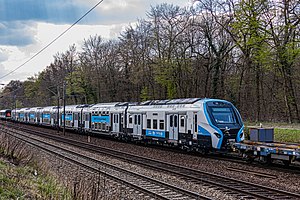Rail transport in Cartadania
This article is a work-in-progress because it is incomplete and pending further input from an author. Note: The contents of this article are not considered canonical and may be inaccurate. Please comment on this article's talk page to share your input, comments and questions. |
Cartadania's railway network is renowned for its extensive coverage, efficient coordination, seamless integration with other modes of transport, and high level of service reliability, contributing to a thriving domestic and trans-sarpedonian freight system despite the country's vast size. This is largely driven by stringent regulations on truck transport and well-coordinated intermodal logistics, which enable the smooth flow of goods and passengers across the country. With an articulate network length of 480,000 kilometers (300,000 mi), Cartadania boasts one of the densest railway networks in Sarpedon. In fact, it is the clear leader in kilometers traveled per inhabitant and year, with an average of 162,285 kilometers (100,839 mi) per person as of 2028. This high intensity of rail travel not only facilitates efficient transportation but also helps to alleviate the burden on the country's roadway infrastructure by reducing the number of vehicles, particularly heavy trucks, on many parts of the network.
| Rail network of Cartadania | |
|---|---|
 | |
| Operation | |
| National railway | Orenvia |
| Infrastructure company | Orenvia Complexo |
| Major operators | Orenvia (ORN) Lealia (LEA) Bay Western Lines (BWL) Northstar (NST) |
| System length | |
| Total | 482,645 km (299,902 mi) |
| Electrified | 98% |
| High-speed | 16,250 kilometers (10,100 mi) |
| Track gauge | |
| Main | 1,435 mm / 4 ft 8+1⁄2 in standard gauge |
| Electrification | |
| Main | 25 kV 60 Hz |
| Total length | 472,991 km (293,903 mi) |
| Features | |
| No. tunnels | 118 |
| Tunnel length | 112.6 km (70.0 mi) |
| Longest tunnel | Carina Bay Bridge Tunnel 5 km (3.1 mi) |
| No. bridges | 1,795 |
| Longest bridge | Marée Channel Bridge-Tunnel 66.1 km (41.1 mi) |
| No. stations | 3,296 |
| Highest elevation | Mariangate Station 1,891.3 m (6,205 ft) |
| Lowest elevation | Añaquín Valley −82.6 m (−271 ft) |
A notable feature of Cartadania's railway network is its widespread electrification, with virtually 100% of the tracks powered by electricity. The few remaining sections that still use steam or diesel locomotives are typically reserved for tourism purposes only. Furthermore, Cartadania boasts a diverse landscape of railway companies, with a total of 31 railway companies operating in the country, providing a competitive and dynamic environment for rail transportation. Public transport, including railways, also plays a significant role in Cartadania's commuter landscape, with a notable 30% of commuters relying on public transport as their main mode of transportation for commuting to work. This reflects the widespread use of railways for daily commuting purposes, highlighting the importance of rail as a reliable and convenient transportation option for Cartadania's workforce.
In terms of goods transportation, rail plays a significant role in Cartadania's modal split, with a substantial 39% share of goods transport performance by road and rail. This underscores the significance of railways as a preferred mode for transporting goods across the country, contributing to the efficient movement of goods and fostering economic development.